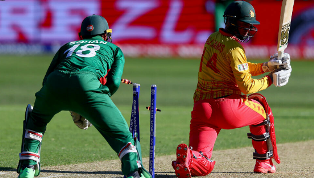Perth: Players and spectators alike were left confused as to what happened in the dramatic final stages of Bangladesh’s Super 12 match against Zimbabwe at The Gabba, but a quick look at the ICC playing conditions reveals the umpires made the right call during the dying stages.
To the naked eye, it looked like Nurul Hasan had completed a clear stumping of Blessing Muzarabani from the final ball of Musaddek Hossain’s over to seal a thrilling victory for Bangladesh, reported the ICC portal.
But with TV umpire Chris Gaffaney called on to check the stumping, the Kiwi official found Hasan had in fact taken the ball prior to it passing the stumps and whipped off the bails in excitement.
While playing under the ICC’s Playing Conditions, the law in question is directly transposed from the MCC laws.
The MCC are the custodians of the Laws of Cricket and Law 39.1.1 states in relation to the stumping dismissal: “The striker is out Stumped, except as in 39.3, if a ball which is delivered is called No ball and he/she is out of his/her ground, other than as in 39.3.1 and he/she has not attempted a run when his/her wicket is fairly put down by the wicket-keeper without the intervention of another fielder. Note, however, Laws 25.6.2 and 25.6.5 (Dismissal and conduct of a batter and his/her runner) and 27.3 (Position of wicket-keeper).”
The key part of that law is the final sentence, which relates to the position of the wicketkeeper and leads us to the next law which considers what the keeper can and can’t do.
Law 27.3.1 states: “The wicket-keeper shall remain wholly behind the wicket at the striker’s end from the moment the ball comes into play until a ball delivered by the bowler touches the bat or person of the striker or passes the wicket at the striker’s end or the striker attempts a run.”
In this case, Hasan was found by Gaffaney to have taken the ball prior to it passing the wicket and that led to a no-ball being correctly called by officiating umpire Marais Erasmus as per Law 27.3.2.
Law 27.3.2 states: “In the event of the wicket-keeper contravening this Law, the striker’s end umpire shall call and signal No ball as soon as applicable after the delivery of the ball.”
Following the no-ball call from Erasmus, players returned to the field with an extra run added to Zimbabwe’s score and four runs required for victory, and the batting side gave a free hit.
Fortunately for Bangladesh, Musaddek fired in an excellent delivery that Muzarabani was unable to get a hold of as the Asian side got a second chance to celebrate the thrilling victory.
Law 27.3.1 was also relevant during the thrilling final moments of India’s clash against Pakistan at the MCG on October 23.
In this case, Pakistan wicket-keeper Mohammad Rizwan was able to collect the ball prior to it passing the stumps as the ball had deflected off the body of India batter Dinesh Karthik.


